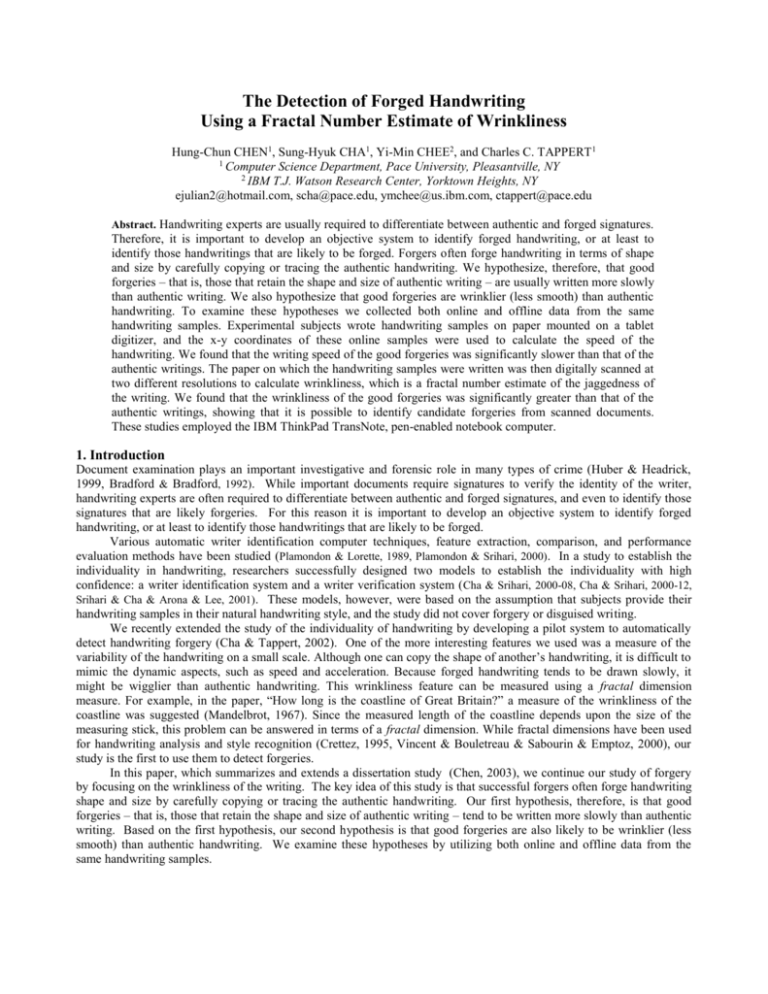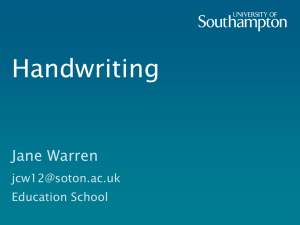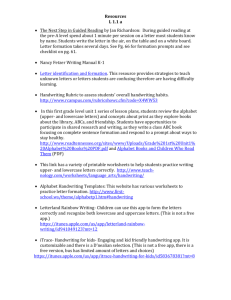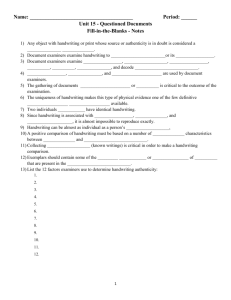The Detection of Forged Handwriting Using a Fractal Number
advertisement

The Detection of Forged Handwriting Using a Fractal Number Estimate of Wrinkliness Hung-Chun CHEN1, Sung-Hyuk CHA1, Yi-Min CHEE2, and Charles C. TAPPERT 1 1 Computer Science Department, Pace University, Pleasantville, NY 2 IBM T.J. Watson Research Center, Yorktown Heights, NY ejulian2@hotmail.com, scha@pace.edu, ymchee@us.ibm.com, ctappert@pace.edu Abstract. Handwriting experts are usually required to differentiate between authentic and forged signatures. Therefore, it is important to develop an objective system to identify forged handwriting, or at least to identify those handwritings that are likely to be forged. Forgers often forge handwriting in terms of shape and size by carefully copying or tracing the authentic handwriting. We hypothesize, therefore, that good forgeries – that is, those that retain the shape and size of authentic writing – are usually written more slowly than authentic writing. We also hypothesize that good forgeries are wrinklier (less smooth) than authentic handwriting. To examine these hypotheses we collected both online and offline data from the same handwriting samples. Experimental subjects wrote handwriting samples on paper mounted on a tablet digitizer, and the x-y coordinates of these online samples were used to calculate the speed of the handwriting. We found that the writing speed of the good forgeries was significantly slower than that of the authentic writings. The paper on which the handwriting samples were written was then digitally scanned at two different resolutions to calculate wrinkliness, which is a fractal number estimate of the jaggedness of the writing. We found that the wrinkliness of the good forgeries was significantly greater than that of the authentic writings, showing that it is possible to identify candidate forgeries from scanned documents. These studies employed the IBM ThinkPad TransNote, pen-enabled notebook computer. 1. Introduction Document examination plays an important investigative and forensic role in many types of crime (Huber & Headrick, 1999, Bradford & Bradford, 1992). While important documents require signatures to verify the identity of the writer, handwriting experts are often required to differentiate between authentic and forged signatures, and even to identify those signatures that are likely forgeries. For this reason it is important to develop an objective system to identify forged handwriting, or at least to identify those handwritings that are likely to be forged. Various automatic writer identification computer techniques, feature extraction, comparison, and performance evaluation methods have been studied (Plamondon & Lorette, 1989, Plamondon & Srihari, 2000). In a study to establish the individuality in handwriting, researchers successfully designed two models to establish the individuality with high confidence: a writer identification system and a writer verification system ( Cha & Srihari, 2000-08, Cha & Srihari, 2000-12, Srihari & Cha & Arona & Lee, 2001). These models, however, were based on the assumption that subjects provide their handwriting samples in their natural handwriting style, and the study did not cover forgery or disguised writing. We recently extended the study of the individuality of handwriting by developing a pilot system to automatically detect handwriting forgery (Cha & Tappert, 2002). One of the more interesting features we used was a measure of the variability of the handwriting on a small scale. Although one can copy the shape of another’s handwriting, it is difficult to mimic the dynamic aspects, such as speed and acceleration. Because forged handwriting tends to be drawn slowly, it might be wigglier than authentic handwriting. This wrinkliness feature can be measured using a fractal dimension measure. For example, in the paper, “How long is the coastline of Great Britain?” a measure of the wrinkliness of the coastline was suggested (Mandelbrot, 1967). Since the measured length of the coastline depends upon the size of the measuring stick, this problem can be answered in terms of a fractal dimension. While fractal dimensions have been used for handwriting analysis and style recognition (Crettez, 1995, Vincent & Bouletreau & Sabourin & Emptoz, 2000), our study is the first to use them to detect forgeries. In this paper, which summarizes and extends a dissertation study (Chen, 2003), we continue our study of forgery by focusing on the wrinkliness of the writing. The key idea of this study is that successful forgers often forge handwriting shape and size by carefully copying or tracing the authentic handwriting. Our first hypothesis, therefore, is that good forgeries – that is, those that retain the shape and size of authentic writing – tend to be written more slowly than authentic writing. Based on the first hypothesis, our second hypothesis is that good forgeries are also likely to be wrinklier (less smooth) than authentic handwriting. We examine these hypotheses by utilizing both online and offline data from the same handwriting samples. This paper is organized as follows. In section 2, we explain the method of collecting both authentic and forged handwriting samples. Section 3 describes the features extraction procedures, section 4 describes the statistical experiments that to prove the hypotheses, and section 5 draws conclusions of this work. 2. Forgery Database Construction In order to study the general problem of forged handwriting we selected ordinary words to forge rather than signatures. Because signatures are generated by a highly learned automatic process we would expect the differences in speed and wrinkliness to be even more pronounced for signatures than for ordinary words. We originally planned to use a set of words that contains all word-initial alphabet characters for both upper and lowercase, and word middle and terminal positions for the lowercase alphabet (Cha et al., 2000-12). However, for this preliminary study we used only one word from the set, the word April. A database of handwriting samples from ten subjects was created. Each of the ten subjects was asked to write the word April three times on provided ruled paper mounted on an IBM ThinkPad TransNote, pen-enabled notebook computer (Fig. 1) in their most natural handwriting style. As expected, the handwritings consisted of both cursive and handprinted words depending on writers’ natural handwriting styles (Fig. 2). Subjects were also asked to forge the word April three times from the handwriting samples of each of the nine other writers. While forging practice was not formalized, the writers tended to practice the forging of each writing sample two or three times. Thus, we obtained 30 authentic samples of the word April (three from each of the ten writers) and 270 forgeries (three word forgeries of the nine other writers from each of the ten writers) for a total of 300 words. Using the IBM Ink Manager SDK, we saved the online data from the IBM TransNote digitizer. In addition, using a Canon CanoScan LiDE 30 Flatbed Scanner, the paper on which the handwriting samples were written was digitally scanned at both 300 and 600 dpi. This yielded a total of 900 database records – 300 online and 600 offline records. The record format consisted of: 1. ID of the subject, 2. Online/offline, 3. ID of the copied subject , 4. Word written, 5. first/second/third try, 6. Sampling rate (online) or resolution (offline), 7. File extension: nbk or txt (online), or jpg (offline). Note that for the authentic handwriting samples item 1 was equal to item 3. Figure 2. Images of authentic handwriting sample. Figure 1. IBM TransNote, pen-enabled notebook PC. 3. Feature Extraction Two measurements were computed for each of the 300 handwritten word samples: the speed of writing the word from the online data and the wrinkliness of the word from the offline data. 3.1. Handwriting Speed The IBM TransNote digitizer recorded the x-y coordinates of the pen movement at a resolution of 100 points/centimeter (254 points/inch) and a sampling rate of 133Hz. From these online data the average speed (velocity) of the pen tip during the writing of each word was computed by dividing the length of the trajectory of the word by the time to write the word. 3.2. Handwriting Wrinkliness The scanned digital handwriting images were in color. Therefore, we thresh-holded the red, green, and blue levels to convert these images into simple binary images represented by a rectangular array where each pixel value was either 0 or 1. Whereas the wrinkliness of the coastline was computed using two different measuring sticks (Mandelbrot, 1967), the wrinkliness of the handwriting can be computed using binary digital images at two different resolutions. One can simply count the number of high and low resolution pixels on the boundary of the handwriting and use the following formula for high _ resolution / log( 2) Wrinklines s log low _ resolution the wrinkliness: where high_resolution is the number of pixels on the boundary of the high resolution handwriting sample, and low_resolution is the number of pixels on the boundary of the low resolution sample. If the writing is a smooth straight line in either the horizontal or the vertical direction, the wrinkliness value is 1. Fig. 3 shows an original handwriting sample, the edge-detected sample, a portion of the edge-detected sample at 300 dpi, and a portion at 600 dpi. 4. Statistical Experiments A sample of the calculated measurements is shown in Table 1, listing the shorthand filename (e.g., 0101T1 means subject 1, copying subject 1, try 1), the number of pixels at 300dpi, the number of pixels at 600dpi, the wrinkliness, and the average pen tip speed. For each of the two hypotheses, we set the level of significance to 5% and applied the t-Test to the data to obtain the probability, p, of the null hypothesis – that the authentic and forged samples came from the same probability distribution. Table 1. A sample of the calculated measurements. Figure 3. Wrinkliness calculation: a) handwriting sample, b) edge-detected sample, c) portion of edgedetected sample at 300 dpi, d) portion at 600 dpi. Filename 300dpi 0101T1 14894 0101T2 8786 0101T3 9258 0202T1 6453 0202T2 6212 0202T3 5824 0.087968122 600dpi 30583 18638 19764 13765 13319 12722 Wrinkliness 1.03799867 1.084968652 1.094102493 1.092962679 1.100356033 1.127243231 Speed 0.11396973 0.107457204 0.118184103 0.093275242 0.094080635 For the speed hypothesis we obtained the value p = 0.0000000059. This extremely low p value clearly indicates that the writing speed of the forgeries was significantly slower than that of the authentic writings, strongly verifying the first hypothesis. For the wrinkliness hypothesis our initial calculation did not show a significant difference between the wrinkliness of the forgery and the authentic writings. However, we then realized that many of the forged writings were obviously poor ones in terms of shape and size, indicating that several of the subjects either did not or could not reasonably mimic the authentic writing. It is usually easy to identify a “poor” forgery compared to a “good” one (Fig. 4). Figure 4. Authentic writing (left), “poor” forgery (center), “good” forgery (right) Also, there were a few cases where one of a writer’s three authentic writing samples differed in writing style – for example, one written cursively and two printed (Fig. 5). Figure 5. Different authentic writing style. We determined by eye and manually eliminated the poor forgeries and the authentic samples written in a different style (about 25 percent of the data), and re-computed the results. This time we found that the wrinkliness of the good forgeries was significantly greater than that of the authentic writings, p = 0.0205. Although not as strong a verification as for the first hypothesis, the second hypothesis was clearly verified, indicating that the wrinkliness of forged writing is significantly greater than that of authentic writing. 5. Conclusions and Recommendations Since writing speed is difficult to quantify in documents that have already been produced, this method provides examiners with a tool for making a more objective and reliable estimate of writing speed. The greater wrinkliness of forged writing is therefore an important result because it shows that it is possible to identify candidate forgeries from scanned documents. We have several future extensions of this study in the planning stages. We plan to redo the study using signatures rather than arbitrary words since writing signatures is a highly learned automatic process and we expect even greater differences in wrinkliness between authentic and forged signatures. To improve the estimates of wrinkliness we will investigate using different resolutions, such as including 150 dpi and 1200 dpi, and experimenting with different edge detection algorithms. We will devise pattern recognition algorithms to filter out the “bad” forged samples automatically to eliminate human judgement from the process. We will experiment with different types of pens and paper to determine their effect on the wrinkliness of the writing. Finally, we plan to investigate computing the speed and wrinkliness features over portions of the writing rather than over the entire word or signature. 6. References Bradford, R. R., & Bradford, B. R (1992). Introduction to Handwriting Examination and Identification, Nelson-Hall Cha, S.-H., & Srihari, S. N. (2000-08). Writer Identification: Statistical Analysis and Dichotomizer, Proc. SPR & SSPR, Alicante, LNCS-Advances in Pattern Recognition, vol. 1876, pp 123-132. Cha, S.-H., & Srihari, S. N. (2000-12). Assessing the Authorship Confidence of Handwritten Items, Proc. 5th WACV 2000, Palm Springs, IEEE Computer Society, pp 42-47. Cha, S.-H., & Tappert, C. C. (2002). Automatic Detection of Handwriting Forgery, Proc. 8th Int. Workshop Frontiers Handwriting Recognition (IWFHR-8), Niagara, Canada, pp 264-267. Chen, H.-C. (2003). Forged Handwriting Detection,” M.S. Dissertation, School of CSIS, Pace University Crettez, J.-P. (1995). A set of handwriting families: style recognition, Proc. ICDAR 95, Montreal, pp 489-494. Huber, R. A., & Headrick, A. M. (1999). Handwriting Identification: Facts and Fundamentals, CRC Press. Mandelbrot, B. B. (1967). How Long is the Coast of Great Britain, Statistical Self Similarity and Fractional Dimension, Science, 155, pp 636-638 Plamondon, R., & Lorette, G. (1989). Automatic signature verification and writer identification – the state of the art, Pattern Recognition 22(2):107-131 Plamondon, R., & Srihari, S. N. (2000). On-Line and Off-Line Handwriting Recognition: a Comprehensive Survey, IEEE Trans. PAMI 22(1):63-84 Srihari, S. N., & Cha, S.-H., & Arona, H., & Lee, S. (2001). Individuality of Handwriting, in Journal of Forensic Sciences, vol 47/4, pp 1-17 Vincent, .N. & Bouletreau, V., & Sabourin, R., Emptoz, H. (2000). How to use fractal dimensions to qualify writings and writers,” Fractals, World Scientific, Vol 8, no. 1, pp 85-97.








